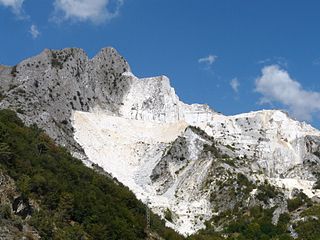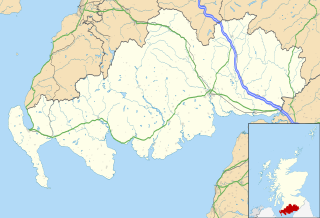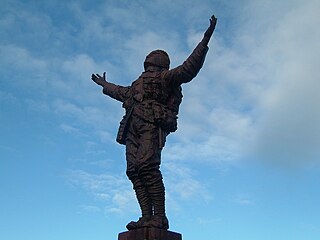Jack Wright (born John Wright, 1850–1929) in Waverton, Cheshire, the eldest son of Joseph and Anne Wright of Avenue Farm, previous of The White Horse Inn, Waverton. [1]

Waverton is a village and civil parish in the unitary authority of Cheshire West and Chester and the ceremonial county of Cheshire, England. It lies about 5 1⁄4 miles (8.4 km) south-east of Chester. It is almost continuous with the village of Rowton to the north west and that in turn is almost continuous with Christleton. According to the 2011 Census, the population of the parish was 1,587.
Born Joseph Wright in Waverton, Cheshire, the second eldest son of Joseph & Ann Wright.
Initially employed as a stonemason in a local sandstone quarry [2] he moved to Ditton, Cheshire and started to establish his kennels for training greyhounds for coursing. [3]

Sandstone is a clastic sedimentary rock composed mainly of sand-sized mineral particles or rock fragments.

A quarry is a type of open-pit mine in which dimension stone, rock, construction aggregate, riprap, sand, gravel, or slate is excavated from the ground.

Ditton is a residential area of Widnes, in the borough of Halton, England. It borders Halebank to the south and west, Hough Green to the north and north west and an area just outside Widnes town centre to the east. Ditton is a local government ward, with a population of 6,249 at the time of the 2001 Census.
By 1891 he moved to Scotland [4] and for many years he acted as dog trainer to Mr Leonard Pilkington of Cavens, Kirkbean (founder of the Pilkington glass firm [5] ). He was appointed manager at Mersehead Farm (now an RSPB nature reserve), where he resided for a number of years, his brother Joe Wright, taking over the training of the dogs for Mr. Pilkington.

Scotland is a country that is part of the United Kingdom. Sharing a border with England to the southeast, Scotland is otherwise surrounded by the Atlantic Ocean to the north and west, by the North Sea to the northeast and by the Irish Sea to the south. In addition to the mainland, situated on the northern third of the island of Great Britain, Scotland has over 790 islands, including the Northern Isles and the Hebrides.

Kirkbean is a small Scottish village and civil parish on the Solway Firth, in the historical county of Kirkcudbrightshire and now in Dumfries and Galloway. In the 2001 census, the four small villages making up the parish of Kirkbean had a total population of 643. The parish also includes the hamlet of Loaningfoot.

Pilkington Group Limited is a multinational glass-manufacturing company headquartered in St Helens, United Kingdom and a wholly owned subsidiary of the Japan-based NSG Group. Prior to its acquisition by NSG in 2006, it was an independent company listed on the London Stock Exchange and for a time was a constituent of the FTSE 100 Index.
For a number of years he was trainer for Mr William Paterson. of Broomlands, Maxwelltown and Watchhall, Annan, Dumfries and Galloway, and on the death of Mr Paterson he took over the kennels at Watchhall, and until 1927, when he retired following an illness, he had acted in the capacity of public trainer. Jack Wright had a wide knowledge and experience of dogs, and many animals, mainly greyhounds, were placed in his charge.

Maxwelltown was formerly a burgh of barony and police burgh and the largest town in the county of Kirkcudbrightshire Scotland. In 1929 Maxwelltown was merged with Dumfries. Map ref.

Annan is a town and former royal burgh in Dumfries and Galloway, south-west Scotland. Historically part of Dumfriesshire, its public buildings include Annan Academy, of which the writer Thomas Carlyle was a pupil, and a Georgian building now known as "Bridge House". The Town Hall was built in Victorian style in 1878, using the local sandstone. Annan also features a Historic Resources Centre. In Port Street, some of the windows remain blocked up to avoid paying the window tax.
On seven occasions he trained winners of the Tenants’ Cup at Kinmount coursing, and also the winner of the Corrie Cup during the time of the meetings at Corrie. He had a dog in the last four at Waterloo Cup meetings on three occasions, and while acting as trainer for the late Mr Pilkington he trained "Phoebus," the winner of the £1000 championship at Kempton Park, London. He was a frequent attender at all the principal meetings in the country, where his abilities earned for him many friends by whom he was much respected.

Coursing is the pursuit of game or other animals by dogs—chiefly greyhounds and other sighthounds—catching their prey by speed, running by sight, but not by scent. Coursing was a common hunting technique, practised by the nobility, the landed and wealthy, and commoners with sighthounds and lurchers. In its oldest recorded form in the Western world, as described by Arrian, the sport was practised by all levels of society, as remained the case until Carolingian period forest law appropriated hunting grounds, or commons, for the king, the nobility, and other land owners.
The coursing meeting for greyhounds that was held at Corrie, near Lockerbie in Dumfries and Galloway consisted of several stakes that were competed for. The meeting took place on land belonging to Andrew Jardine of Lanrick Castle, brother of Robert Jardine.

The Waterloo Cup was a coursing event. The three-day event was run annually at Great Altcar in Lancashire, England from 1836 to 2005 and it used to attract tens of thousands of spectators to watch and gamble on the coursing matches. It was founded by The 2nd Earl of Sefton and, originally, was supported by his patronage.
His brothers Joe Wright, and Tom Wright, were well known in sporting circles, and on seven occasions trained winners of the Waterloo Cup. [6]
Born Joseph Wright in Waverton, Cheshire, the eldest son of Joseph & Anne Wright of Avenue Farm, previous of The White Lion Inn.
Thomas Edward Wright (1861–1956) is an English greyhound trainer. His family was known for its success during the late 19th century. He is the youngest son of Joseph & Anne Wright of Avenue Farm in Waverton, Cheshire. One of seven children, he followed his brothers Jack Wright and Joe Wright into greyhound training.
He died in 1929 aged 79, at Watchhall, Annan, Dumfries and Galloway his youngest son Hardy Wright took over management of the kennels and subsequently won the Waterloo Cup on two occasions.
